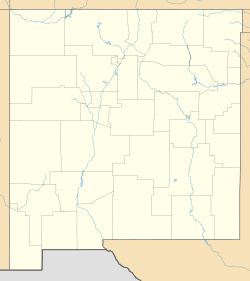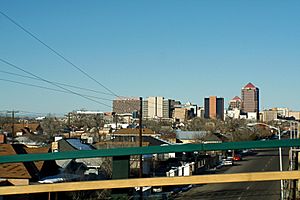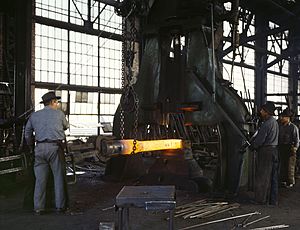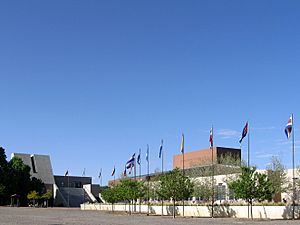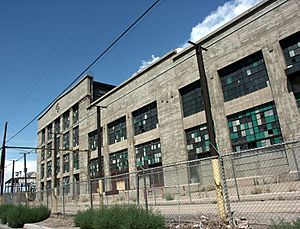Barelas facts for kids
Quick facts for kids
Barelas
|
|
|---|---|
|
Neighborhood of Albuquerque
|
|
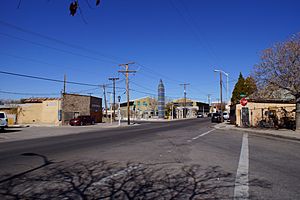
4th St. in Barelas
|
|
| Country | |
| State | |
| City | Albuquerque |
| Area | |
| • Total | 0.94 sq mi (2.4 km2) |
| Elevation | 4,947 ft (1,508 m) |
| Population
(2010)
|
|
| • Total | 3,382 |
| • Density | 3,598/sq mi (1,389/km2) |
| Time zone | UTC-7 (Mountain Time Zone) |
| • Summer (DST) | UTC-6 (Mountain Daylight Time) |
| ZIP Code |
87102, 87104
|
| Area code(s) | 505 |
| GNIS feature ID | 898630 |
Barelas is a historic neighborhood in Albuquerque, New Mexico. It sits just south of Downtown. This area is shaped like a triangle, bordered by Coal Avenue, the BNSF railroad tracks, and the Rio Grande river.
Barelas was once its own village. It became part of Albuquerque in the 1880s when the railroad brought a lot of growth. Even so, it still has its own special feel. Barelas was officially started in 1662. This makes it the oldest neighborhood in the city, even older than Old Town. For a long time, Barelas faced economic challenges. But things have changed since the National Hispanic Cultural Center opened in 2000. The area is now seeing new development.
The main shopping area in Barelas is important. It is listed on the National Register of Historic Places. This means it is a special historical site.
Contents
Where is Barelas?
Barelas is shaped like a triangle. It is located between the Rio Grande river and the BNSF railroad tracks. Coal Avenue forms its northern border with Downtown. The Barelas Neighborhood Association area goes south to Woodward Road. However, south of Bridge Boulevard, the area becomes more industrial. Barelas is somewhat separated from other areas. The railroad yard and river act as natural boundaries.
Who Lives in Barelas?
Barelas is home to about 3,700 people. Around two-thirds of them are Hispanic. Historically, it has been one of Albuquerque's less wealthy neighborhoods.
History of Barelas
Early Days
The Barelas area was once a key river crossing. It was on El Camino Real de Tierra Adentro. This was a major Spanish trade route through New Mexico. In 1807, explorer Zebulon Pike described the crossing. He said it was wide but shallow and easy to cross.
A settlement was officially planned here in 1662. This was done by Governor Diego de Peñalosa. But the area stayed mostly empty until the 1800s. The name Barelas likely comes from a local ranch owner. His name was Pedro Varela (or Barela).
In the late 1800s, Barelas was a quiet farming village. Records show 309 residents in 1870. By 1880, there were 350 people. Barelas even saw a small part of the American Civil War. This happened during the Battle of Albuquerque in April 1862. Soldiers in Barelas exchanged artillery fire with another position. No one was hurt in this exchange.
The Railroad Boom Years
The Atchison, Topeka and Santa Fe Railway arrived in Albuquerque in 1880. The railroad wanted a straight path. So, they built the main station about 1.5 miles east of the old town. This led to a "New Town" growing quickly next to the station. This new area was just north of Barelas.
Barelas changed a lot because of the railroad. The huge Santa Fe Railway Shops were built nearby. These shops became Albuquerque's biggest employer. Barelas quickly changed from a quiet farm village to a busy neighborhood. Many people who lived there worked for the railroad. By 1900, over 1,200 people lived in Barelas. Most of Barelas became part of Albuquerque in 1891. This marked the end of it being a separate community.
Barelas became even more successful after 1926. That year, 4th Street, a main road through the neighborhood, became part of U.S. Route 66. Soon, the road was full of gas stations, garages, and cafes. These businesses served the many travelers passing through Barelas.
A Time of Decline
Barelas faced several economic problems in the mid-1900s. The first big change was in 1937. Route 66 was moved to a new path. This new route was 90 miles shorter. But it also meant Route 66 no longer went through Barelas on 4th Street. Instead, it used Central Avenue. Traffic on 4th Street dropped even more when Interstate 25 replaced U.S. 85. This new highway became Albuquerque's main north-south road.
To make things worse, the railroad shops closed in 1970. This meant 1,500 jobs were lost in Barelas. Then, in 1974, a part of 4th Street downtown was closed. This was to build Civic Plaza. This cut off the neighborhood's main road. Barelas became isolated and its economy struggled.
New Beginnings
Barelas has been slowly improving since the late 1980s. More people want to live near Downtown. A big change happened in 2000. The National Hispanic Cultural Center opened. This was a $50 million project. It brought visitors and money back into the neighborhood.
In 2001, the Albuquerque Hispano Chamber of Commerce opened. The Barelas Job Opportunity Center also opened. These have helped the economy in Barelas. Another important project is planned for the old railyard. It has been empty since the 1970s. This project is still being planned. But it has already made land in Barelas more valuable.
In 1997, the shopping area on 4th Street was recognized. It was listed on the National Register of Historic Places. It is known as the Barelas-South Fourth Street Historic District.
Schools in Barelas
Albuquerque Public Schools runs two elementary schools in Barelas. Dolores Gonzales Elementary is the main school for the neighborhood. Coronado Elementary has a special program. It teaches students in two languages. Older students from Barelas go to Washington Middle School. They also attend Albuquerque High School. These schools are just outside the neighborhood.
Getting Around Barelas
Barelas used to have two major highways. These were U.S. Route 85 and U.S. Route 66. Both highways followed 4th Street south. Then they turned west across the Barelas Bridge. These highways were later moved. But 4th Street and Bridge Boulevard are still the main roads in Barelas. The bridge is still important for local traffic.
Public buses serve Barelas. ABQ RIDE has routes 53 Isleta and 54 Bridge/Westgate. These routes follow 8th Street and 4th Street. You can find more train and bus connections. They are a few blocks north of Barelas. This is at the Alvarado Transportation Center.
Famous People from Barelas
- Rudolfo Anaya, a well-known author
- Dennis Chavez, a U.S. senator
- Alphonse Gallegos, an Auxiliary Bishop of Sacramento
Places to Visit in Barelas
- National Hispanic Cultural Center
- Rio Grande Zoo
- Barelas Coffee House
- Tingley Field (no longer exists)
Historic Places in Barelas
Besides the Barelas-South Fourth Street Historic District, several other places in Barelas are on the National Register of Historic Places. These are important historical sites:
- A&P Superintendent's House
- AT&SF Railway Locomotive Shops
- Barelas Community Center
- Coronado School
- Charles W. Lewis Building
- Newlander Apartments
- Shoup Boardinghouse (no longer exists)
- West San Jose School
Barelas in Movies and TV
Barelas has been featured in popular culture. Time and Again Barelas is a three-act opera. It was written by Miguel del Aguila. The opera premiered in 2006 at the National Hispanic Cultural Center. It was part of Albuquerque's 300th birthday celebration.
The empty railyard complex in Barelas is a popular filming spot. Many movies have been filmed there, including:
- Beerfest (2006)
- The Spirit (2008)
- Gamer (2009)
- Terminator Salvation (2009)
- The Avengers (2012)
The first episode of Terminator: The Sarah Connor Chronicles also used the railyard. Many scenes from the TV show Breaking Bad were filmed there too.


